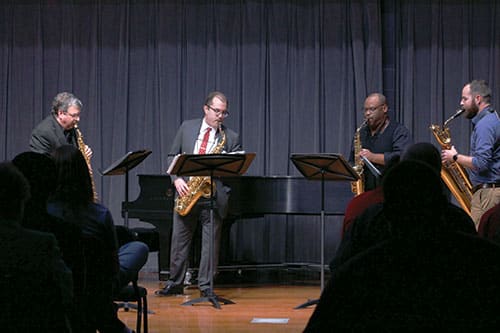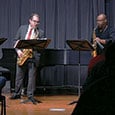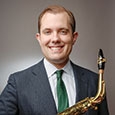In the last twenty years, saxophone quartets have become ubiquitous. They are featured chamber ensembles at many state music conventions, and fine groups perform each year at the Midwest Clinic. Incredible high school groups from across the country give professional-level performances in the Houston Underground Saxophone Competition. In the college world, saxophones have dominated the Fischoff, MTNA, and Coltman chamber music competitions. Where do these groups come from, and how can they help your students?

Why Quartets?
Chamber groups of all kinds can inspire talented students. These ensembles may be able to perform more difficult music than the full band or explore repertoire that directly fits the tastes of the students. Saxophone quartets can also satisfy young players who prefer the tenor or baritone voice. If a student wants to explore a new saxophone type, the quartet is an excellent laboratory to gain comfort and facility.
As an educational tool, chamber ensembles can spur greater musical independence. The democratic structure of small groups encourages students to make artistic choices in repertoire. This sense of ownership and the skills that it engenders can open greater avenues for continued music making. Small ensembles also offer ideal opportunities for mentorship: More advanced students with leadership potential can be paired with younger musicians, yielding opportunities for peer tutoring.
Finally, saxophone quartets and other small groups can widen the public relations mission of the school band. It may be impractical for a full band to play for every civic function in a community, but small groups can perform anywhere. If enough chamber ensembles exist within the program, the band can increase its public presence without overtaxing students.
History
Saxophone quartets are nearly as old as the instrument itself. The range, versatility, and timbral cohesion of the saxophone family made the soprano, alto, tenor, and baritone combination a logical extension of Adolphe Sax’s ideas from the earliest days. Beginning in the 1860s, less than two decades after inventing the instrument, Sax published original works for quartets by Jean-Baptiste Singelee and Jerome Savari that are still performed.
Later in the 19th Century, the quartet came to America. In addition to his pioneering work as a saxophone soloist for the bands of Patrick Gilmore and John Philip Sousa, Edward Lefebre formed the New York Saxophone Quartette Club in the 1880s. The group included the earlier French standards in their repertoire and commissioned new works, including Caryl Florio’s Allegro de Concert.
Despite these early activities, saxophone quartets remained obscure until the 20th Century. Then, saxophone pioneers introduced the ensemble to wider audiences. In the late 1920s, Marcel Mule and other members of the French Republican Guard Band formed a quartet. Through this ensemble and the later Paris Saxophone Quartet and Marcel Mule Quartet, dozens of composers wrote now-standard works for SATB groups, including Alexander Glazunov, Gabriel Pierne, Eugene Bozza, and Alfred Desenclos. Similarly, near the end of his groundbreaking career as a saxophone soloist, Sigurd Rascher founded his eponymous quartet in 1969, resulting in even more quartet literature.
Along with their work as performers, Mule and Rascher were active teachers. They and University of Michigan saxophone professor Larry Teal advocated for the educational use of saxophone quartets among their students, leading to the ensembles spreading throughout the world. Now, quartets exist in most collegiate music programs, and many high school and middle school music programs include them as well.
Instrumentation
Most professional-level literature across the saxophone quartet’s existence has been written for the soprano, alto, tenor, and baritone instrumentation (SATB). However, there is a wide body of pedagogical and developmental literature for the AATB configuration. There is even a small body of repertoire for AAAA or AAAT groups, if local conditions favor such an instrumentation (The Saxophone Quartet collections of the Apollo Saxophone Quartet Series, published by Astute Music, are an ideal resource for the latter groups).
Forming a Quartet
One of the greatest determining factors in student success is motivation. If students have buy-in, there is a great chance that they will be able to achieve their goals and yours. A student may approach you wishing to form a quartet. If they are given independence (with proper supervision) and support to do so, the sky will be the limit. Many budding saxophonists hear chamber groups online, where there is a wealth of fine recordings. If there is no organic desire to form such groups, the pump can be primed a bit by sharing exciting performances of excellent, modern literature with students.
Once the desire to form an ensemble exists, consider the personnel. A group of four students may self-select to form a group. If this happens, do not worry if the instrumentation is askew. Four alto players can easily learn the other saxophone voices if needed. If one or more students is motivated, consider picking promising younger students to fill out the group. Even if their playing experience lags behind their older peers, enthusiasm, and achievement, can be infectious. Dedicated intermediate students can make big strides when paired with advanced colleagues.
Organization
Any educator who has played in a college chamber group will be familiar with the standard ensemble coaching: A group meets weekly with an instructor. The teacher gives feedback, and the group rehearses independently throughout the week, applying the advice. This model also works with younger groups, given modifications for the age and level of the student.
If a wider chamber ensemble program is desired, weekly coaching for each group will prove impractical. Instead, a floating method may be used, as described in my Duet Club article (June 2018 Instrumentalist). Chamber ensembles can be spread throughout the rehearsal space, before or after school, or during a dedicated period. In early instruction, the director can show all students common organizational, tuning, and rehearsal procedures. Then, the director can float between groups, offering brief feedback before moving to other groups.
A similar strategy can succeed with a single quartet. The group might rehearse at the end of the school day, and the director can deal with office tasks while monitoring the group. The teacher should always offer suggestions based on their musical experience and perspective with the goal of guiding the ensemble to greater independence.
Rehearsing
Directors should establish basic rehearsals procedures from the outset – warm-up, tuning, fundamentals, and repertoire rehearsal. For a new group, fundamentals may fill a large part of rehearsal, but never forget that people play music to play music. Performance goals from the first day can provide shape, structure, and form to a young chamber ensemble’s vision. A short gig after a month can kickstart any quartet.
As a warm-up, the group can perform something as simple as a unison scale, with attention to ensemble articulation, movement together, blend, and intonation. A simple scalar exercise can help students feel comfortable with visual communication. Many young musicians feel at ease performing with a conductor, but in a quartet, students must learn to play without one. Instead of having students count each other off, encourage them to practice body cues in these warm-up exercises.
Once instruments are warm, tuning should take place. Intonation comes from the ears, not the eyes, so the quartet should tune together, rather than from individual visual tuners. The lowest voice should tune either concert Bb or concert A. Once this pitch is in-tune, the baritone player (or whoever is the lowest) should look at the rest of the ensemble members. The tenor player should tune to the pitch first, then, while the baritone and tenor continue to play, the next highest voice tunes, etc., until the group has pure intonation, with well-supported, full sounds.
In the group fundamentals block, the quartet can use many of the same exercises that bands employ. Scales in rounds (resulting in diatonic chords) are a wonderful option, as are unison Remington exercises. The quartet should remain focused on pure intonation, balance, blend, articulation style, and ensemble in attacks and releases. Chorales are also an excellent resource. Standard options written for quartet include John Nichol’s Five Bach Chorales (scored for either SATB or AATB quartets) published by Watchdog Music or Dan Gelok’s Chorales for Saxophone Quartet, published by Murphy Music Press. David Newell’s Bach and Before for Band (Kjos), also works well for saxophone quartet.
A new resource from Conway Publications is Chops 3: The Sinta Quartet Method, a nearly inexhaustible resource for building and refining quartet sound. Through all these fundamental exercises, visual communication and the development of cuing for all players should be developed, along with musical principles.
In the repertoire rehearsal, good habits of individual and group practice should be strengthened. In the early stages, a clearly audible metronome (perhaps a phone with a powerful speaker) can build group precision and technical accuracy. Small-chunk practicing should be encouraged with an emphasis on intonation, balance, and blend.
Even the youngest groups can explore musical ideas (e.g. How short should this staccato be? How do we want it to compare to this tenuto?) and express their opinions. To encourage musical independence, each rehearsal should have a designated leader. While every voice in the group should be equal, the leader can steer and guide the conversation. From rehearsal to rehearsal, this role should shift, giving each member a chance to hone musical decision-making.
Repertoire
Incredible repertoire exists for the saxophone quartet. Unfortunately, as with saxophone solo repertoire, most of this music is for collegiate or professional players. After the mid-20th century, developmental literature for saxophone quartet was neglected by composers, arrangers, and publishers. Many warhorse resources can still help young groups, however. The following readily available collections for AATB quartet can fulfill the needs of intermediate performers:
• First Book of Saxophone Quartets, arr. by Himie Voxman (Southern)
• Five Centuries for Saxophone Quartet, arranged by Sigurd Rascher (Bourne)
• Quartet Repertoire for Saxophone, arr. by Himie Voxman (Rubank)
• Ten Saxophone Quartets, arr. by Larry Teal (Schirmer)
As groups advance, many other works of yesteryear will appeal to today’s young musicians. Bill Holcombe’s wonderful arrangements for Musicians Publications can provide quality options for holiday and patriotic concerts. Lenny Niehaus’s arrangements and original works, published by Kendor, range from gorgeous lyricism to ebullient, jazz-soaked fun. The British publisher Saxtet also offers quality arrangements and new compositions at a variety of ability-levels.
For some young saxophonists, these options may not be enough. Students who are inspired by the exciting, professional level works of Chris Evan Hass, David Biedenbender, or Jenni Watson may want something more. Luckily, several saxophone educators are filling in the gaps in developmental repertoire. This allows eager students with less technical or musical maturity to play exciting music by contemporary composers as their skills grow.
The Assembly Quartet (Jeff Heisler, Ian Jeffress, Matthew Younglove, and Adam Estes) have undertaken a long-term project to commission and promote excellent repertoire by diverse composers in both SATB and AATB configurations for developing quartets. This project has yielded new works by Hass (such as his Final Boss), Avner Dorman, Gala Flagello, Russell Holland, Marc Mellits, Steven Bryant, and many others that will appeal to modern students and are also developmentally appropriate for high school groups. Assembly’s website has an invaluable list of educational works, including such gems as Fernande Decruck’s Pavane, Henry Cowell’s Sailor’s Hornpipe, and Rendez-Vous by Andre Waignein. (www.assemblyquartet.com)
Listening Examples
YouTube and other streaming services allow saxophonists to hear a world of wonderful examples. The PRISM Quartet is a leader in the saxophone quartet field. Since their founding forty years ago, they have commissioned works by such luminaries as William Bolcom, Julia Wolfe, and Jennifer Higdon. For the past decade, the group’s roster has included Timothy McAllister (University of Michigan), Zachary Shemon (University of Missouri-Kansas City), Matthew Levy (Temple University), and Taimur Sullivan (Northwestern University), all leading soloists, teachers, and chamber musicians.
The pantheon of saxophone quartets also includes the Capitol Quartet, who have premiered works by Stacy Garrop, John Anthony Lennon, and Carter Pann. Their roster is also a Who’s Who of the American saxophone world: Christopher Creviston (Arizona State University), Joseph Lulloff (Michigan State), David Stambler (Pennsylvania State University), and Henning Schroeder (Western Michigan University) all serve as current members.
Along with these long-established groups, younger quartets are also fixtures of the genre that can inspire any student. The H2 Quartet’s incredibly polished, exciting, and beautiful recordings should be required listening for any young saxophonist. In addition to their pedagogical contributions mentioned above, the Sinta Quartet and the Assembly Quartet will likewise inspire any young performer. I also shamelessly recommend my Palmetto Saxophone Quartet.
The saxophone quartet has become an international medium. Leaders in France in the form are the Quatuor Habanera and the Quatuor Ellipsos. Japanese saxophone virtuoso Nobuya Sugawa is the long-time leader of the incredibly refined Trouvere Quartet, and Masato Kumoi’s eponymous quartet is notable for its prowess, as well its long-term association with composer David Maslanka.
The saxophone quartet is a vibrant ensemble that can inspire students and supply tools for musical growth. This can lead to making music far past their school years. In addition, the quartet can extend a band program’s reach deeper into the community. It’s another way to help music shape young lives and to share beauty with the world.






